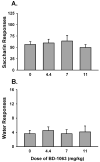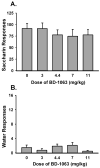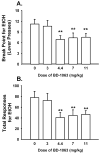The sigma-receptor antagonist BD-1063 decreases ethanol intake and reinforcement in animal models of excessive drinking
- PMID: 18946467
- PMCID: PMC2669694
- DOI: 10.1038/npp.2008.192
The sigma-receptor antagonist BD-1063 decreases ethanol intake and reinforcement in animal models of excessive drinking
Abstract
Sigma-Receptors (SigRs) have been implicated in behavioral and appetitive effects of psychostimulants and may also modulate the motivating properties of ethanol. This study tested the hypothesis that SigRs modulate ethanol reinforcement and contribute to excessive ethanol intake. The effects of subcutaneous treatment with the potent, selective Sig-1R antagonist BD-1063 on operant ethanol self-administration were studied in two models of excessive drinking-Sardinian alcohol-preferring (sP) rats and acutely withdrawn ethanol-dependent Wistar rats-and compared to ethanol self-administration in nondependent Wistar controls. To assess the specificity of action, the effects of BD-1063 on self-administration of an equally reinforcing saccharin solution were determined in Wistar and sP rats. Gene expression of Sig-1R in reward-related brain areas implicated in ethanol reinforcement was compared between ethanol-naive sP and Wistar rats and withdrawn ethanol-dependent Wistar rats. BD-1063 dose dependently reduced ethanol self-administration in sP rats (3.3-11 mg/kg) and withdrawn, dependent Wistar rats (4-11 mg/kg) at doses that did not modify mean ethanol self-administration in nondependent Wistar controls. BD-1063 did not reduce concurrent water self-administration and did not comparably suppress saccharin self-administration, suggesting selectivity of action. BD-1063 also reduced the breakpoints of sP rats to work for ethanol under a progressive-ratio reinforcement schedule. Ethanol-naive sP rats and 24-h withdrawn, dependent Wistar rats showed reduced Sig-1R mRNA expression in the nucleus accumbens. The results suggest that SigR systems may contribute to innate or ethanol-induced increases in susceptibility to self-administer high ethanol levels, identifying a potential neuroadaptive mechanism contributing to excessive drinking and a therapeutic target for alcohol abuse and dependence.
Conflict of interest statement
Disclosure/Conflicts of interest
The authors declare no conflicts of interest.
Figures







Similar articles
-
Activation of σ-receptors induces binge-like drinking in Sardinian alcohol-preferring rats.Neuropsychopharmacology. 2011 May;36(6):1207-18. doi: 10.1038/npp.2011.5. Epub 2011 Feb 23. Neuropsychopharmacology. 2011. PMID: 21346735 Free PMC article.
-
Sigma-1 receptor mediates acquisition of alcohol drinking and seeking behavior in alcohol-preferring rats.Behav Brain Res. 2015;287:315-22. doi: 10.1016/j.bbr.2015.03.065. Epub 2015 Apr 4. Behav Brain Res. 2015. PMID: 25848705 Free PMC article.
-
Selective reduction of alcohol drinking in Sardinian alcohol-preferring rats by a sigma-1 receptor antagonist.Psychopharmacology (Berl). 2009 Aug;205(2):327-35. doi: 10.1007/s00213-009-1548-x. Epub 2009 May 14. Psychopharmacology (Berl). 2009. PMID: 19440699 Free PMC article.
-
Animal models of alcoholism: neurobiology of high alcohol-drinking behavior in rodents.Crit Rev Neurobiol. 1998;12(4):339-69. doi: 10.1615/critrevneurobiol.v12.i4.40. Crit Rev Neurobiol. 1998. PMID: 10348615 Review.
-
Ethanol drinking in rodents: is free-choice drinking related to the reinforcing effects of ethanol?Alcohol. 2008 Feb;42(1):1-11. doi: 10.1016/j.alcohol.2007.10.005. Alcohol. 2008. PMID: 18164576 Free PMC article. Review.
Cited by
-
Antagonism of sigma-1 receptors blocks compulsive-like eating.Neuropsychopharmacology. 2012 Nov;37(12):2593-604. doi: 10.1038/npp.2012.89. Epub 2012 Jun 20. Neuropsychopharmacology. 2012. PMID: 22713906 Free PMC article.
-
mTOR activation is required for the anti-alcohol effect of ketamine, but not memantine, in alcohol-preferring rats.Behav Brain Res. 2013 Jun 15;247:9-16. doi: 10.1016/j.bbr.2013.02.030. Epub 2013 Mar 4. Behav Brain Res. 2013. PMID: 23466691 Free PMC article.
-
Novel Highly Potent and Selective Sigma1 Receptor Antagonists Effectively Block the Binge Eating Episode in Female Rats.ACS Chem Neurosci. 2020 Oct 7;11(19):3107-3116. doi: 10.1021/acschemneuro.0c00456. Epub 2020 Sep 21. ACS Chem Neurosci. 2020. PMID: 32886484 Free PMC article.
-
Corticotropin releasing factor-induced amygdala gamma-aminobutyric Acid release plays a key role in alcohol dependence.Biol Psychiatry. 2010 May 1;67(9):831-9. doi: 10.1016/j.biopsych.2009.11.007. Epub 2010 Jan 8. Biol Psychiatry. 2010. PMID: 20060104 Free PMC article.
-
Sigma Receptor Ligands Are Potent Antiprion Compounds that Act Independently of Sigma Receptor Binding.ACS Chem Neurosci. 2024 Jun 5;15(11):2265-2282. doi: 10.1021/acschemneuro.4c00095. Epub 2024 May 14. ACS Chem Neurosci. 2024. PMID: 38743607 Free PMC article.
References
-
- Alonso G, Phan V, Guillemain I, Saunier M, Legrand A, Anoal M, et al. Immunocytochemical localization of the sigma(1) receptor in the adult rat central nervous system. Neuroscience. 2000;97(1):155–170. - PubMed
-
- Altshuler HL, Phillips PE, Feinhandler DA. Alteration of ethanol self-administration by naltrexone. Life sciences. 1980;26(9):679–688. - PubMed
-
- Aydar E, Palmer CP, Klyachko VA, Jackson MB. The sigma receptor as a ligand-regulated auxiliary potassium channel subunit. Neuron. 2002;34(3):399–410. - PubMed
-
- Bastianetto S, Rouquier L, Perrault G, Sanger DJ. DTG-induced circling behaviour in rats may involve the interaction between sigma sites and nigro-striatal dopaminergic pathways. Neuropharmacology. 1995;34(3):281–287. - PubMed
-
- Booth RG, Baldessarini RJ. (+)-6,7-benzomorphan sigma ligands stimulate dopamine synthesis in rat corpus striatum tissue. Brain research. 1991;557(1–2):349–352. - PubMed
Publication types
MeSH terms
Substances
Grants and funding
LinkOut - more resources
Full Text Sources
Medical

